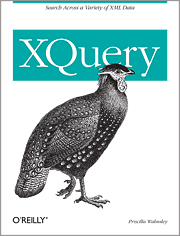fn:nilled
Whether an element is nilled (has xsi:nil="true")
Description
The fn:nilled function determines whether an element is nilled, in the sense of W3C XML Schema. In a schema, element declarations can designate elements as nillable. This allows them to appear in an instance document empty, even if their type would otherwise require them to have some content (either character data or children or both).
An element is not considered to be nilled just because it is empty. For an element to be nilled, it must have an attribute xsi:nil whose value is true. Nilled elements are always empty; it is not valid for an element to have content and also have the xsi:nil attribute set to true.
On the other hand, some elements may be validly empty, but not be nilled. This may occur if an element has a complex type that specifies all optional children, or a simple type that allows blank values, such as xs:string. To test for an empty (but not necessarily nilled) element, you can use the expression string($node) = "".
It is useful to be able to check for a nilled element using the fn:nilled function to avoid unexpected results. For example, suppose you want to subtract the value of a discount element from the value of a price element. If the discount element is nilled, its typed value will be the empty sequence, and the result of the expression price - discount will be the empty sequence. You can avoid this using the expression price - (if nilled(discount) then 0 else discount).
This description is © Copyright 2007, Priscilla Walmsley. It is excerpted from the book XQuery by Priscilla Walmsley, O'Reilly, 2007. For a complete explanation of this function, please refer to Appendix A of the book.
Arguments and Return Type
| Name | Type |
|---|---|
$arg |
node()? |
| return value | xs:boolean? |
Examples
<xsl:variable name="in-xml" as="item()*"> | ||
| ||
</xsl:variable> |
| XPath Example | Results | |
|---|---|---|
| These examples assume that the input has been schema validated. | ||
nilled($in-xml//child[1]) |
false |
|
nilled($in-xml//child[2]) |
true |
|
nilled($in-xml//child[3]) |
false |
|
nilled($in-xml//child[4]) |
false |
|
nilled($in-xml//child[5]) |
false |
|
See Also
| fn:empty | Whether a value is the empty sequence |
| fn:exists | Whether an argument is the empty sequence |
History
| Published On | Last Updated | Contributor(s) |
|---|---|---|
| 2006-06-27 | 2007-02-26 | W3C, XQuery 1.0 and XPath 2.0 Functions and Operators, http://www.w3.org/TR/xpath-functions/ |

